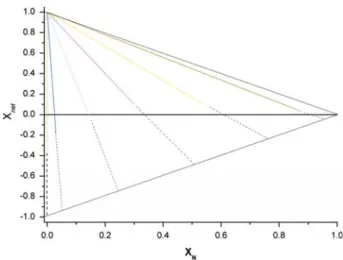J Math Chem (2009) 45:882–883 DOI 10.1007/s10910-008-9469-1
E R R AT U M
Universality behaviour for polarity formation
in channel-type inclusion compounds
Athanasios Batagiannis
· Thomas Wüst ·
Jürg Hulliger
Published online: 25 September 2008
© Springer Science+Business Media, LLC 2008
Erratum to: J Math Chem
DOI 10.1007/s10910-008-9433-0
Table 1 in the original article is missing some text and characters. The table should
read as follows:
Table 1 Guest–guest and
host–guest interaction energies Eij Range (kJ mol−1)
EAD −25.0 to 0.01
EAA 0.01 to 10.0
EDD −5.0 to 5.0
ECj −5.0 to 5.0
In Eq. 6, a subscript character is missing; the equation should appear as follows:
P
i j=
X e
−β(Ei j+EC j)Z
i(6)
Figures 3 and 8 appear in color in the online version of the article. Where dashes
appear in the captions of the original, there should be written out the corresponding
color terminology.
Therefore the caption to Fig.
3
should read:
The online version of the original article can be found under doi:10.1007/s10910-008-9433-0. A. Batagiannis· T. Wüst · J. Hulliger (
B
)Department of Chemistry and Biochemistry, University of Berne, Freiestrasse 3, 3012 Berne, Switzerland
e-mail: publication.hulliger@iac.unibe.ch
J Math Chem (2009) 45:882–883 883
Fig. 3 Net polarity Xnet, as a function of XN, the fraction of non-polar guests included in the crystal. Xnet is plotted for various values of Xg(dark blue line: Xg = 0.05, light blue line: Xg = 0.25, purple line: Xg= 0.5, yellow line: Xg= 0.75, green line: Xg= 0.95). Interactions energies were randomly chosen within the energy range given in Appendix 1. Dashed curves were obtained from calculations using an extended hypothetical energy range (−100 < Ei j < 100 kJ mol−1). The solid black lines show the upper limits of Xnetas a function of XN
Fig. 8 The effect of temperature on polarity for various concentrations Xg(black line: Xg= 0, light blue line: Xg = 0.00001, red line: Xg = 0.0001, purple line: Xg = 0.0003, green line: Xg = 0.001, dark blue line: Xg = 0.01). The interaction energies used for the calculations were EAD = −25 kJmol−1, EAA= 5kJmol−1and EDD= −5kJmol−1. Surprisingly, a very small amount of neutral D–π–D mole-cules in the gas phase can have a strong effect on polarity as temperature is varied

